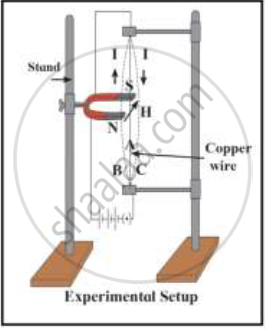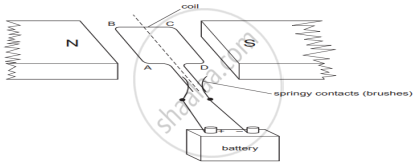Advertisements
Advertisements
Question
Name any two factors on which the strength of magnetic field produced by a current-carrying solenoid depends. How does it depend on these factors?
Solution
The strength of magnetic field produced by a current-carrying solenoid depends on:
(i) The number of turns in the solenoid:
If the number of turns in the solenoid is large, they will produce greater magnetism.
(ii) The nature of core material used in making the solenoid:
If a soft iron rod is used as core in the solenoid, it produces strongest magnetism.
APPEARS IN
RELATED QUESTIONS
What are the various ways in which the strength of magnetic field produced by a current-carrying circular coil can be increased?
State and explain the Clock face rule for determining the polarities of a circular wire carrying current.
Name the type of magnet with which the magnetic field pattern of a current-carrying solenoid resembles
A current-carrying conductor is held in exactly vertical direction. In order to produce a clockwise magnetic field around the conductor, the current should passed in the conductor:
(a) from top towards bottom
(b) from left towards right
(c) from bottom towards top
(d) from right towards left
The force exerted on a current-carrying wire placed in a magnetic field is zero when the angle between the wire and the direction of magnetic field is:
45°
60°
90°
180°
A flat coil ABCD is freely suspended between the pole of U-shaped permanent magnet with the plane of coil parallel to the magnetic field.
What happens when a current is passed in the coil?
i) Which principle is explained in this figure?
ii) Which rule is used to find out the direction of a force in this principle?
iii) In which machine this principle is used? Draw a diagram showing working of that machine

A simple motor is made in a school laboratory. A coil of wire is mounted on an axle between the poles of a horseshoe magnet, as illustrated.

In the example above, coil ABCD is horizontal and the battery is connected as shown.
- For this position, state the direction of the force on the arm AB.
- Why does the current in the arm BC not contribute to the turning force on the coil?
A copper wire is held between the poles of a magnet

The current in the wire can be reversed. The pole of the magnet can also be changed over. In how many of the four directions shown can the force act on the wire?
Assertion (A): A current carrying straight conductor experiences a force when placed perpendicular to the direction of magnetic field.
Reason (R): The net charge on a current carrying conductor is always zero.
